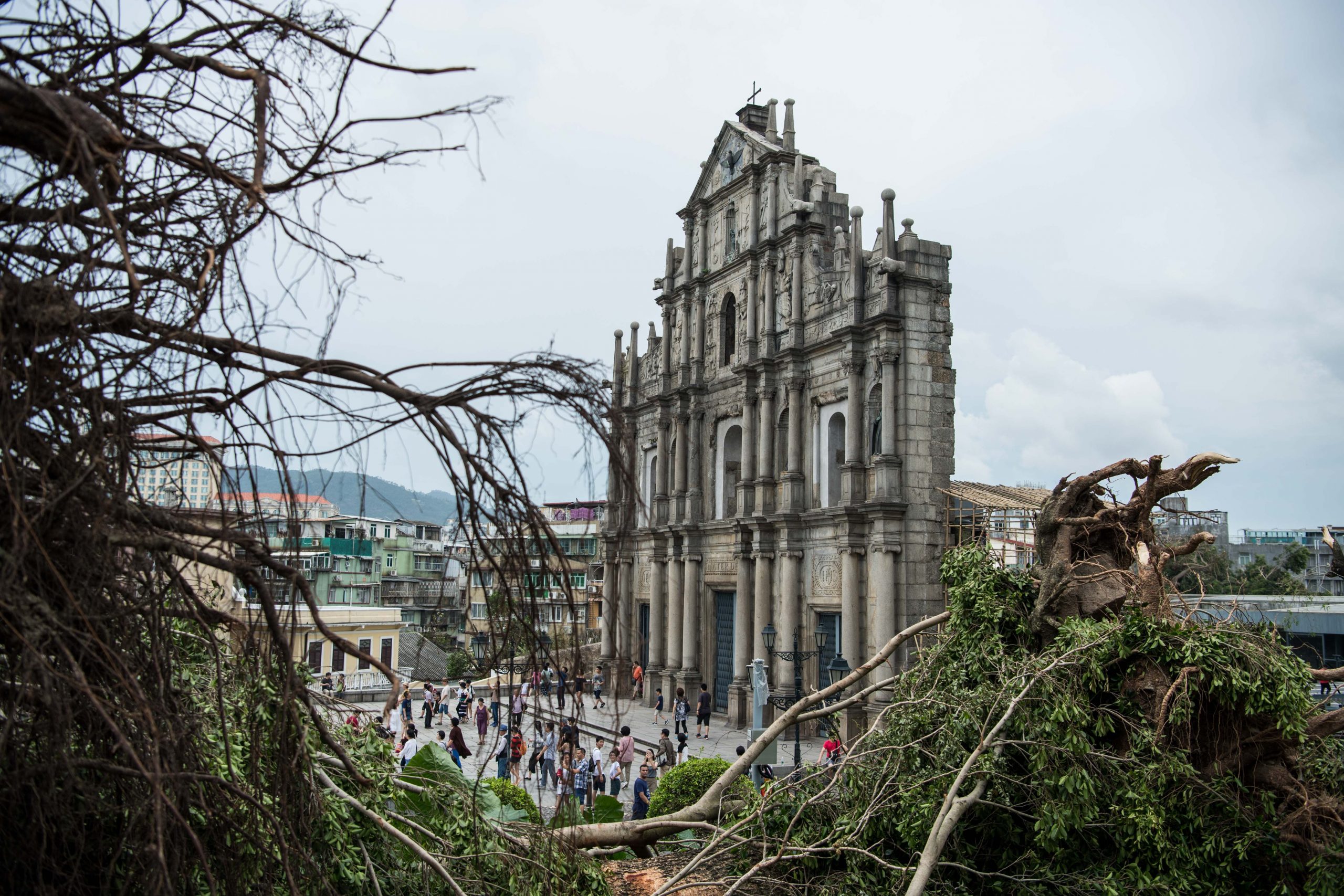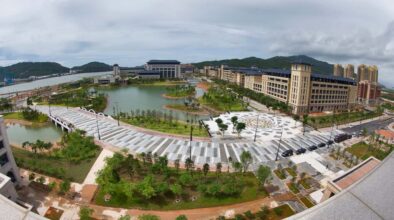TEXT Catarina Mesquita
Super Typhoon Hato ripped through Macao, marring the face of the city but giving rise to a wave of solidarity among its citizens. It has left behind a city irrevocably changed
In a recent interview, Jorge Rangel, president of the International Institute of Macao and a member of one of the oldest families in the territory, confessed that being born in Macao has instilled in him the capacity to survive anything. “This is a land of typhoons, and despite the storms that pass, the capacity to get up the next day and start again is always present,” he explained.
It is a challenge the city has recently had to face anew. Macao rose in a wave of solidarity after 23rd August 2017, the day that Typhoon Hato – the most violent storm to hit the territory in 53 years – left 10 dead, dozens injured, and a trail of destruction unimaginable in the sunny days leading up to it. The interview with Rangel took place in a garden that barely exists today, another victim of the strong winds Hato unleashed on the territory.
Severe gusts of up to 217.4 km/h on the morning of 23rd August saw Macao’s Meteorological and Geophysical Bureau hoist typhoon signal 10 for the first time in 18 years. During what many described as two hours of terror, Macao was isolated: maritime, air, and land borders were closed.
The typhoon left the city unrecognisable: felled trees, damaged scaffolding, broken fences, advertisements for commercial establishments torn off their hinges, shattered windows, and several locations left completely flooded, particularly the Inner Harbour and Barra areas.
Damage to infrastructure left some buildings without water for more than three days. The northwestern part of the city was hardest hit, as the Ilha Verde Water Treatment Plant took more than 48 hours to repair damage to its water service pumps. Forty thousand people also found themselves without electricity.
People queued at various locations around the city, filling buckets with water from fire hydrants or one of the 20 tanker trucks sent from Guangdong province to assist citizens. Shower facilities and changing rooms at four public swimming pools were opened to accommodate residents without running water.

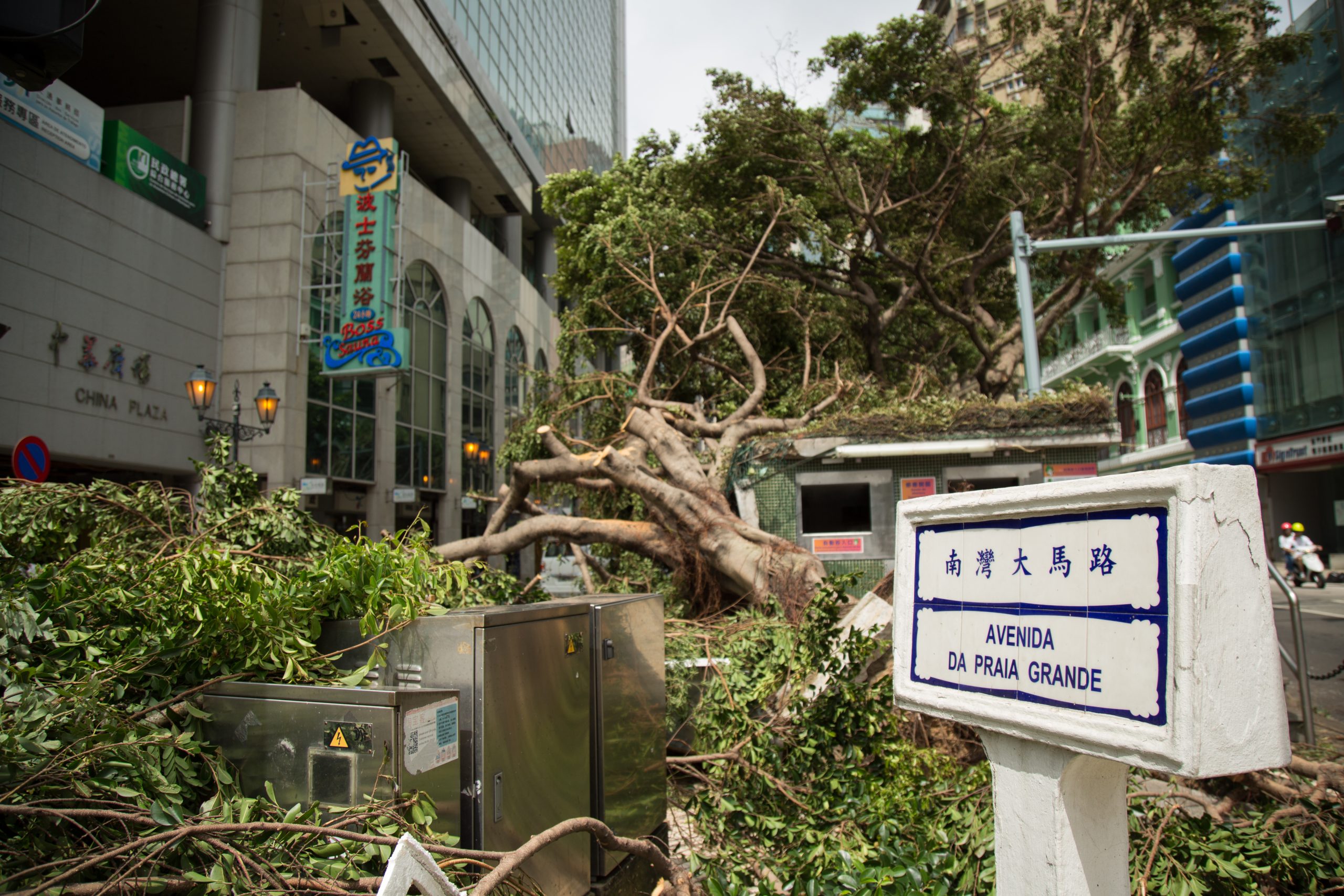
The scene was one of total devastation, from the peninsula to the islands of Taipa and Coloane, in the wake of what many reports called one of the strongest storms on record to hit the territory. The experiences of long‑time residents supported the claim as many suffered losses well beyond those sustained in typhoons going back decades. Lee, an employee at a grocery store in Coloane village, saw the business where she has worked for more than 20 years destroyed by the force of the wind and rain.
“We keep a lot of stock at the door of the grocery store and on Tuesday [22nd August] we kept to our routine of leaving things on the street, despite knowing that the typhoon was on its way,” she explained. “In recent times signals have been hoisted, but the winds don’t really affect us. We didn’t think this was going to be serious.” Past experiences had never resulted in vegetables, fruit, boxes, sacks, and bottles being dragged down the street. This time almost everything disappeared, and she confessed, she didn’t even know where they ended up.
However unprepared, the population wasted no time in banding together with various communities from Chinese to Portuguese, Filipino to Indonesian, coming together to help each other salvage what they could.
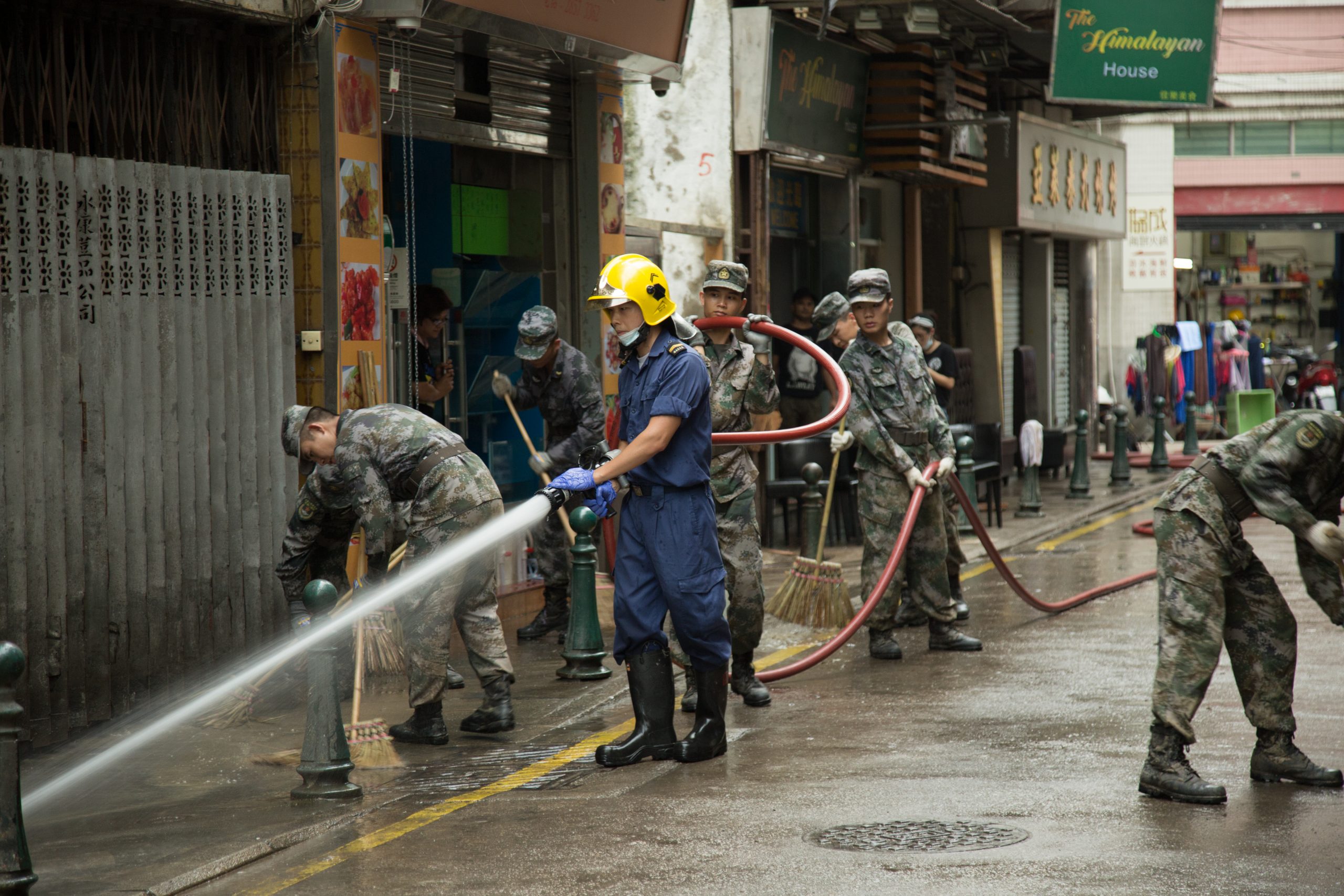
The construction of a lower deck on Sai Van Bridge since 2004 allows for traffic between Macao and Taipa Island to continue up to typhoon signal 8, despite strong winds

All Hands on Deck
The typhoon made international news and the published images of the response showed hundreds of citizens in the streets, sleeves rolled up and hard at work cleaning up the destruction surrounding them. But their efforts paled in comparison to the task at hand. For the first time since the handover in 1999, the People’s Liberation Army Macao Garrison was deployed, 1,000 garrison soldiers ready to assist in the clean up. The deployment followed Chinese central government authorisation of a request made by the Macao government, in accordance with the Basic Law.
Streets littered with rubbish and debris, flooded parking lots strewn with cars, and commercial outlets destroyed, left without electricity or water, were just some of the tasks at hand. With Tropical Storm Pakhar set to hit the city just four days after Hato, the clean up became a race against time.
According to official data, 20,000 volunteers were mobilised for support and clean‑up action. By the time typhoon signal 8 was hoisted for Pakhar, their incredible efforts saw electricity, drinking water, and bottled water supplies nearly restored. Many volunteers, together with the Social Welfare Bureau, provided support to the elderly who found themselves isolated, without access to water or electricity, on the upper floors of some buildings.
For all of the loss suffered, numerous success stories emerged amid the devastation. Loreto Mijares Jr, a Filipino non‑resident worker, saved an elderly couple being swept away by the rapid flooding and high winds in Barra. Speaking to the media, Loreto recounted the experience: “I was scared because it was my first time facing a typhoon and I had no experience in saving drowning people in a mass flood.” Mijares immediately waded into the rushing water despite being a poor swimmer. “I couldn’t resist, I knew I had to save them anyhow.” Residents in nearby apartments threw down lifelines, which Mijares and a local man used to pull the couple to relative safety.

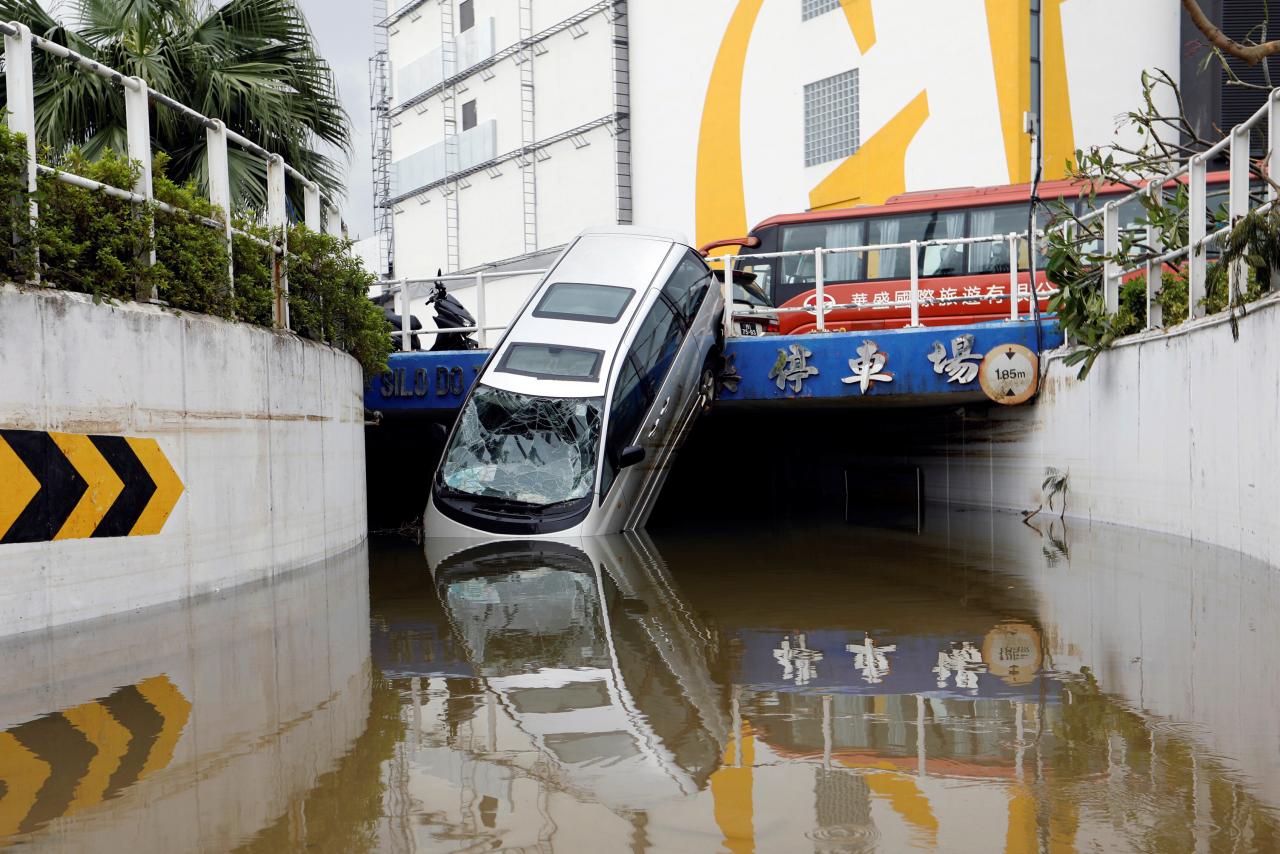
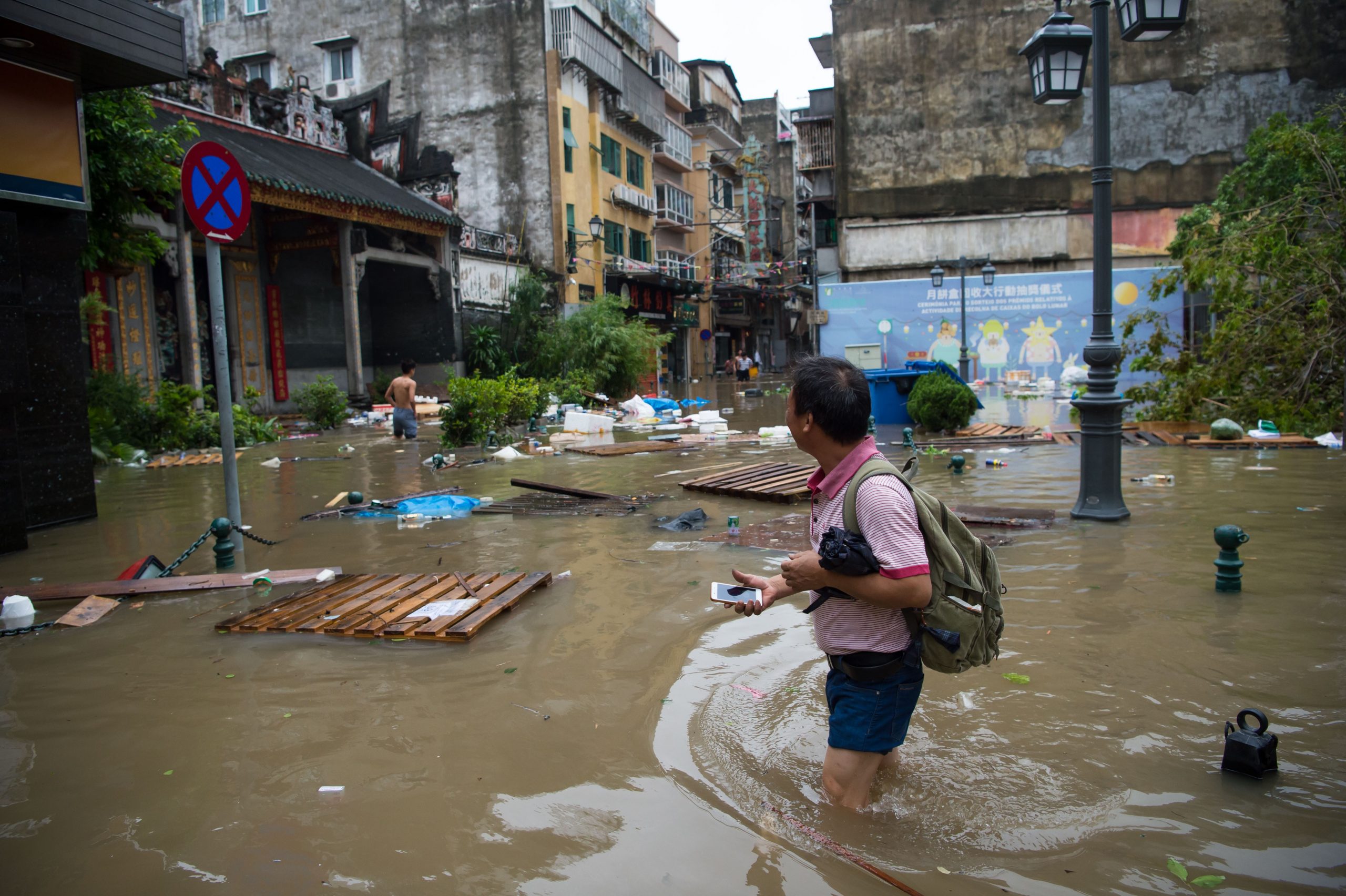
Eddy Ko, 28, was also caught in the rushing water with his wife, who cannot swim. The couple found safety when strangers opened their door to them despite the risks. “Lots of water came in, but they saved us,” Ko told the South China Morning Post (SCMP).
Alice Wu, a columnist for SCMP who was in Macao during and after Hato, summed it up best: “Seeing the devastation for myself was important, but witnessing the droves of volunteers, many of them young people, out on the streets doing whatever they could to help is what will stay with me. These acts of kindness signal hope in unthinkable loss, and demonstrate the human capacity for goodness in heartbreak.”
Billions In Financial Losses
The Macao government estimates financial losses caused by the typhoon total MOP11.47 billion (US$1.47 billion), with direct losses of MOP8.31 billion (US$1.03 billion) and MOP3.16 (US$393 million) billion in indirect losses, according to official data released by the Secretary for Economy and Finance on 6th September. Although estimating the losses took two weeks, vast amounts of financial aid were immediately forthcoming from both the public and private sectors.
Macao Economic Services (DSE), through the Industrial and Commercial Development Fund, began paying out financial aid just days after Hato hit. As of 6th September, financial aid to micro, small, and medium‑sized enterprises provided through the scheme had reached MOP175 million (US$21.7 million). Of the 10,869 requests submitted, 3,499 had been approved. The Macao government increased the size of the subsidy from MOP30,000 to MOP50,000 (US$6,214) as the full extent of the difficulties faced by recipients became evident. The DSE is also offering an interest‑free loan of up to MOP600,000 (US$74,655); more than half of the applications received applied for both support schemes.
Small and medium‑sized enterprises (SMEs) and individuals can apply for a new loan program launched by Banco Nacional Ultramarino (BNU), one of the two note-issuing banks in the territory, with subsidised interest rates and a 30‑month grace period. Companies that have already applied for the government loan programme are still eligible for BNU loans.
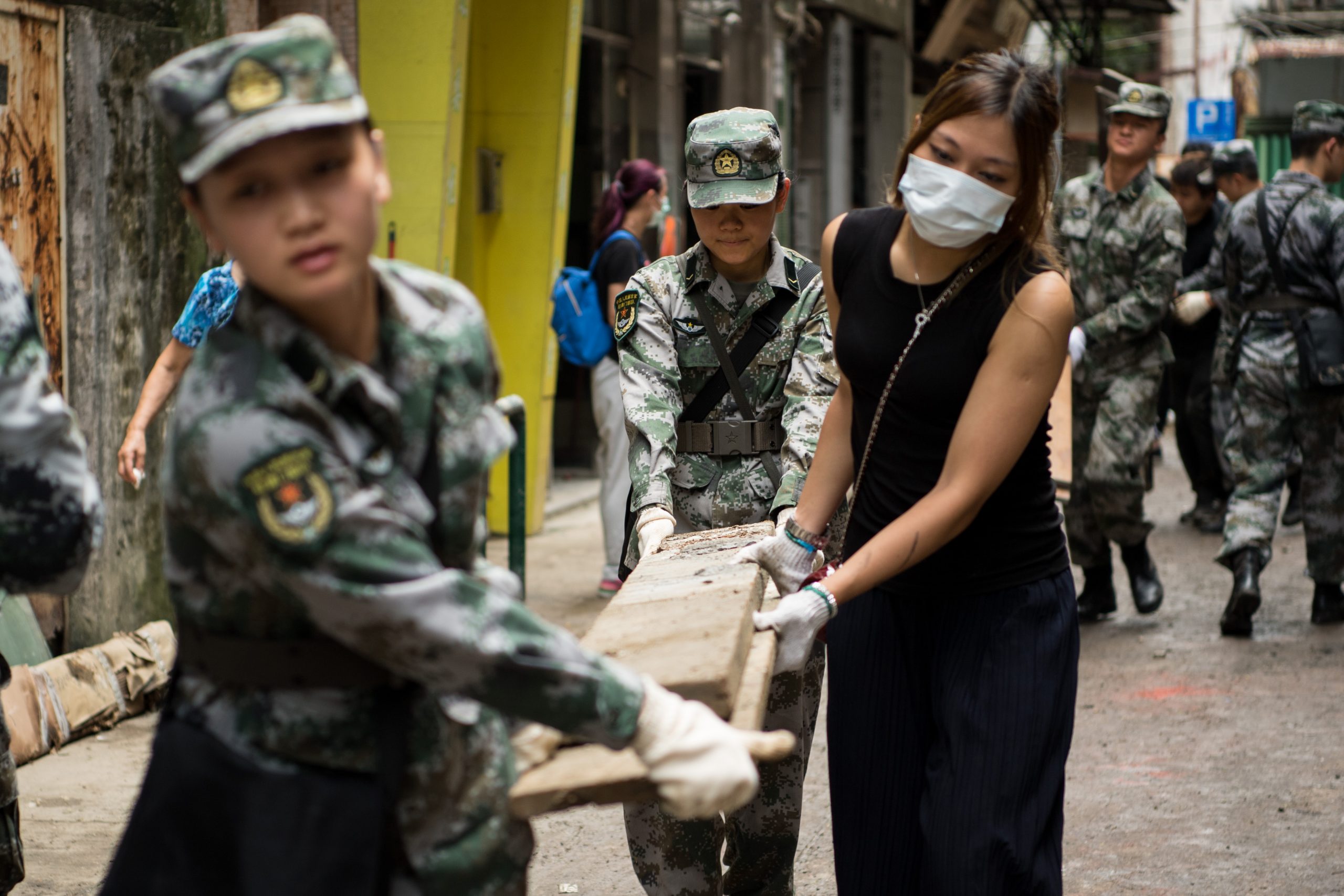
The Macao Foundation launched the “Project of Special Assistance to Damages Caused by the Passage of Typhoon Hato” to provide assistance to those carrying out “consolidation work” on damaged windows and doors. The foundation also provided families with MOP300,000 (US$37,282) in condolences for each of the people killed in the storm, and offered to cover expenses for citizens who received treatment on 23–24 August in one of the city’s three hospitals.
Water supply company Macao Water confirmed that customers affected by the lack of water and electricity will receive MOP1,000 (US$124) compensation in invoices corresponding to the month of August. This follows a similar move by electricity company, CEM.
The Macao government estimates financial losses caused by the typhoon at MOP.47 billion (US$1.47 billion)
Many of the gaming concession companies, major institutions in the gaming hub, stepped up to offer immediate aid to those impacted by the typhoon. Sands China Ltd deployed subsidiary Cotai Water Jet to transport bottled water from Hong Kong to Macao and sent thousands of staff out to clear debris in streets and schools. Melco Resorts & Entertainment Ltd halted work on its Morpheus hotel project, sending out all 2,000 construction workers and 500 Melco staff volunteers to distribute bottled water and clear debris. SJM Holdings Ltd opened washroom facilities at the dog racetrack for residents in Fai Chi Kei without water or electricity. The company also set up a staff volunteer team to assist the community, and offered a month of free medical care to those in need at a local healthcare centre.
Many citizens also pledged financial aid for long‑term relief, recovery, and rebuilding efforts. Sands China announced a MOP65 million (US$8.1 million) donation, with MOP30 million from the company and MOP35 million from the Adelson Family Foundation. Galaxy Entertainment Group (GEG) made a similar announcement, pledging a total of MOP60 million (US$7.46 million), split evenly between the GEG Foundation and the Lui family who founded the company. Melco, MGM China and Wynn pledged MOP30 million (US$3.75 million) to the typhoon relief effort.
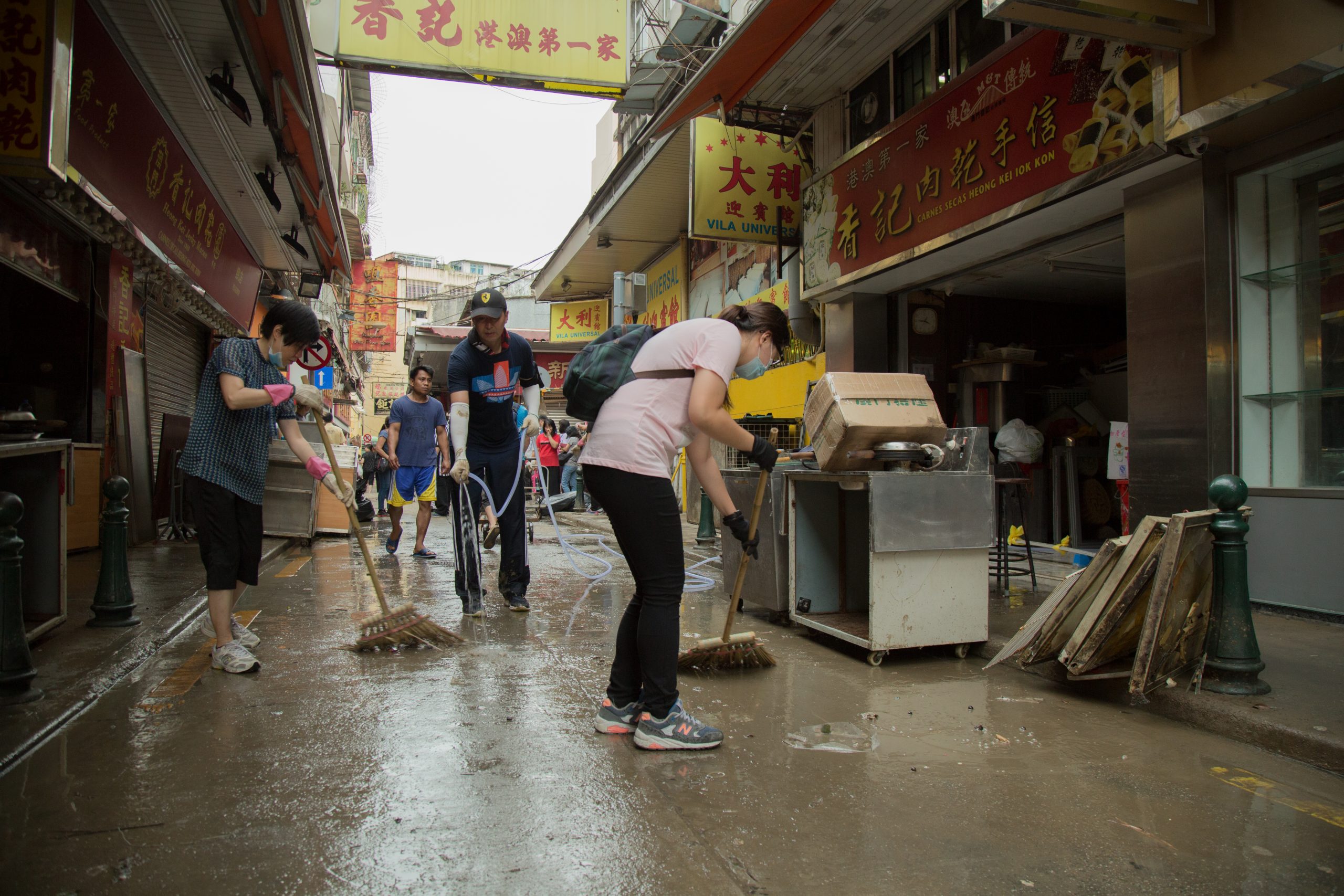
Surviving Heritage
An assessment requested by Secretary for Social Affairs and Culture Alexis Tam Chon Weng revealed most of the UNESCO heritage buildings, such as the Ruins of St. Paul, were in good condition after the typhoon. Those that sustained damages due to felled trees or utility outages received assistance from Cultural Affairs Bureau (IC) staff.
Over the past 50 years, Macao averaged 5.6 typhoons per year
The Macao Cultural Centre is among the sites overseen by the IC that are closed until further notice, its roof badly damaged by high winds. Collapsed trees damaged some of the boundary walls of Guia Fortress and the typhoon signal post there fell over nearby houses. Four libraries in the territory – Mobile, Patane, Red Market, and Wong Ieng Kuan – are temporarily closed due to damage; Coloane Library re‑opened 1st September, along with Mount Fortress Garden, the Ox Warehouse, and the Treasure of Sacred Art of St. Joseph’s Seminary. Other sites will re‑open as the necessary inspections and maintenance take place.
The Macao Government Tourist Office (MGTO) called for tours to Macao to be postponed until 2nd September. According to data provided by the tourism industry, more than 2,000 tourist groups from mainland China were scheduled to visit Macao during the suspension period, 25th August–1st September. Preliminary statistics found a 28 per cent decrease in the number of visitors during the suspension compared to the same period last year.
Damaged infrastructure and facilities, as well as the diversion of resources to the rebuilding effort, led MGTO to cancel the 29th Macao International Fireworks Display Contest. Previously scheduled for September and October, the annual event is one of the largest on Macao’s calendar.
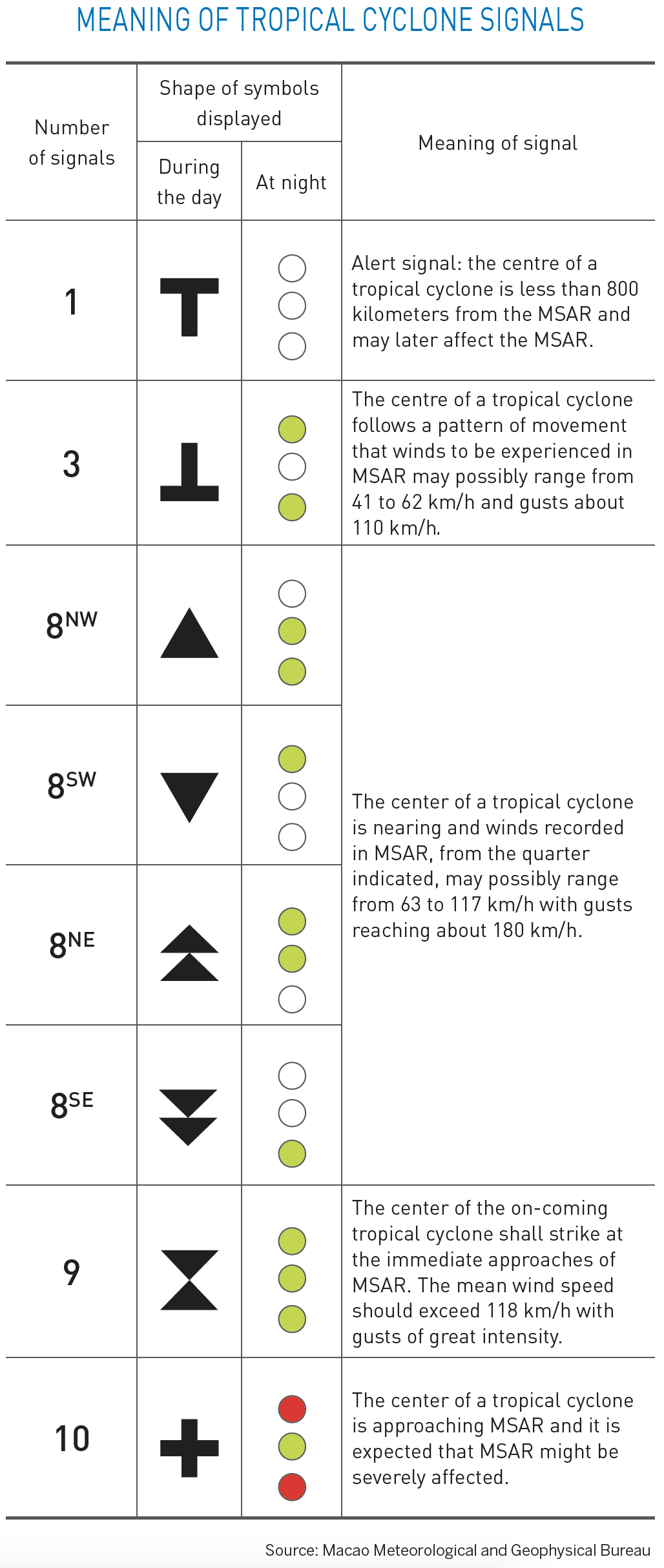
Winds of Change
In Macau e os Tufões (1985) by Joaquim Baião Simões, geographical engineer and former director of Macao’s Meteorological and Geophysical Bureau, the conclusions read: “Let us not forget that ‘Typhoon’ is synonymous with violence and existence of destructive forces of great proportions.
Over the past 50 years, Macao averaged 5.6 typhoons per year
The message is: “Prudence, Vigilance, and Awareness of the Situation.”
The devastating winds of Super Typhoon Hato brought this message to the forefront. Now people shudder every time there is news of a tropical storm forming in the Philippine Sea, moving in the direction of Macao.
The government has set up a commission to review existing mechanisms and improve them in the face of similar catastrophic situations. The Committee for the Review of the Mechanism for Responding to Major Disasters and its Follow‑up and Improvement consists of Chief Executive Chui Sai On, the five policy secretaries, the commissioner‑general of the Unitary Police Service, and the director‑general of the Macao Customs Service.
In a press conference, Chui announced that the mechanism review committee had come up with a raft of measures aimed at enhancing the city’s ability to respond to major disasters, including strong typhoons.
Macao Water will upgrade the flood protection for its Ilha Verde Water Treatment Plant while the government plans to build more water storage tanks on high ground, increasing the city’s tap water reserves. The power supply will also be upgraded, with new natural gas‑powered electricity generators decreasing reliance on outside sources and raised substations, with those in flood‑prone areas given priority.
Public emergency shelter facilities will be provided on higher ground and residents in the Inner Harbour area, among the hardest hit by flooding, will be evacuated if storm surge is high enough to overcome the floodgates along the waterfront.
The government set up a committee to review the mechanism of how to respond to major disasters and a commission to review existing response mechanisms and how to improve them in the face of future catastrophes
The planned formation of a new entity, the Civil Protection and Contingency Coordination Bureau, was announced by Secretary for Security Wong Sio Chak during the press conference. If approved by the legislature, the new bureau would enable increased efficiency in disaster response and oversee the Civil Protection Operations Centre, currently run by the Unitary Police Service. Wong also announced plans for a second civil protection operations centre building.

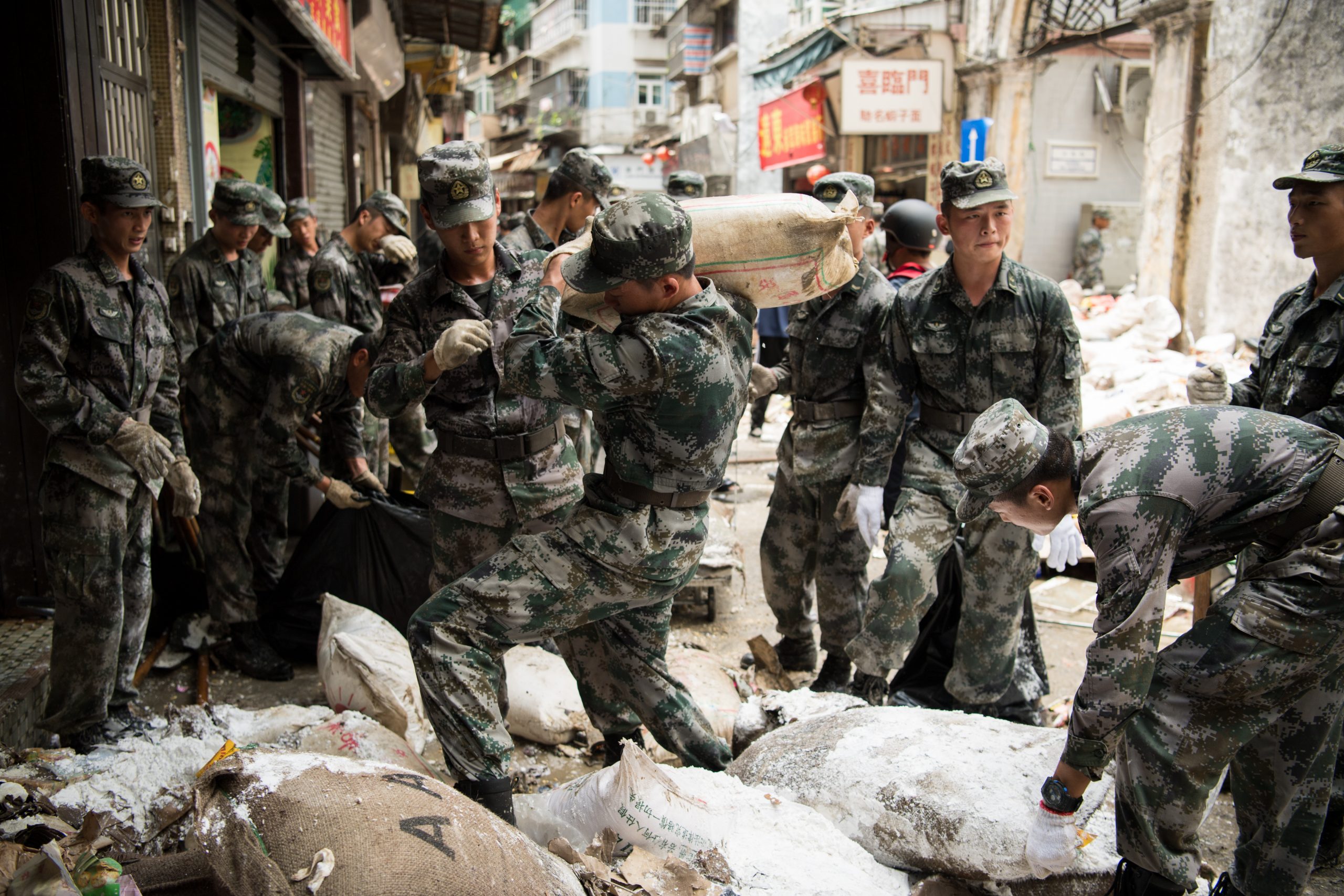
The winds that swept across Macao tore apart trees and buildings, but not its people, drawn together in greater solidarity as they pick up the pieces. Each day since that fateful August morning, Macao rises and moves through its routines, cautious but determined.
The typhoon has become a conversation starter among the community, one that knows there is still much to do. Each person, in one way or another, has a story to share about how the typhoon affected their life. A resident of Ocean Gardens residential area in Taipa commented: “My morning jog by the river is no longer practiced. The trees, and even the wall, are gone, and the most pleasant part of the city has disappeared.” The nodding heads of other residents confirmed this statement: the promenade is unrecognisable, and is just one example of many.
Typhoon season is not over yet. A look around at buildings show the windows still intact marked with tape in the shape of an X, an effort to avoid possible shattering should another powerful typhoon strike.
Speaking before the storm, Jorge Rangel described Macao as a city “fortunate to be blessed by Catholic saints and Chinese gods.” But not relying in divine forces, Macao became a more cautious city.
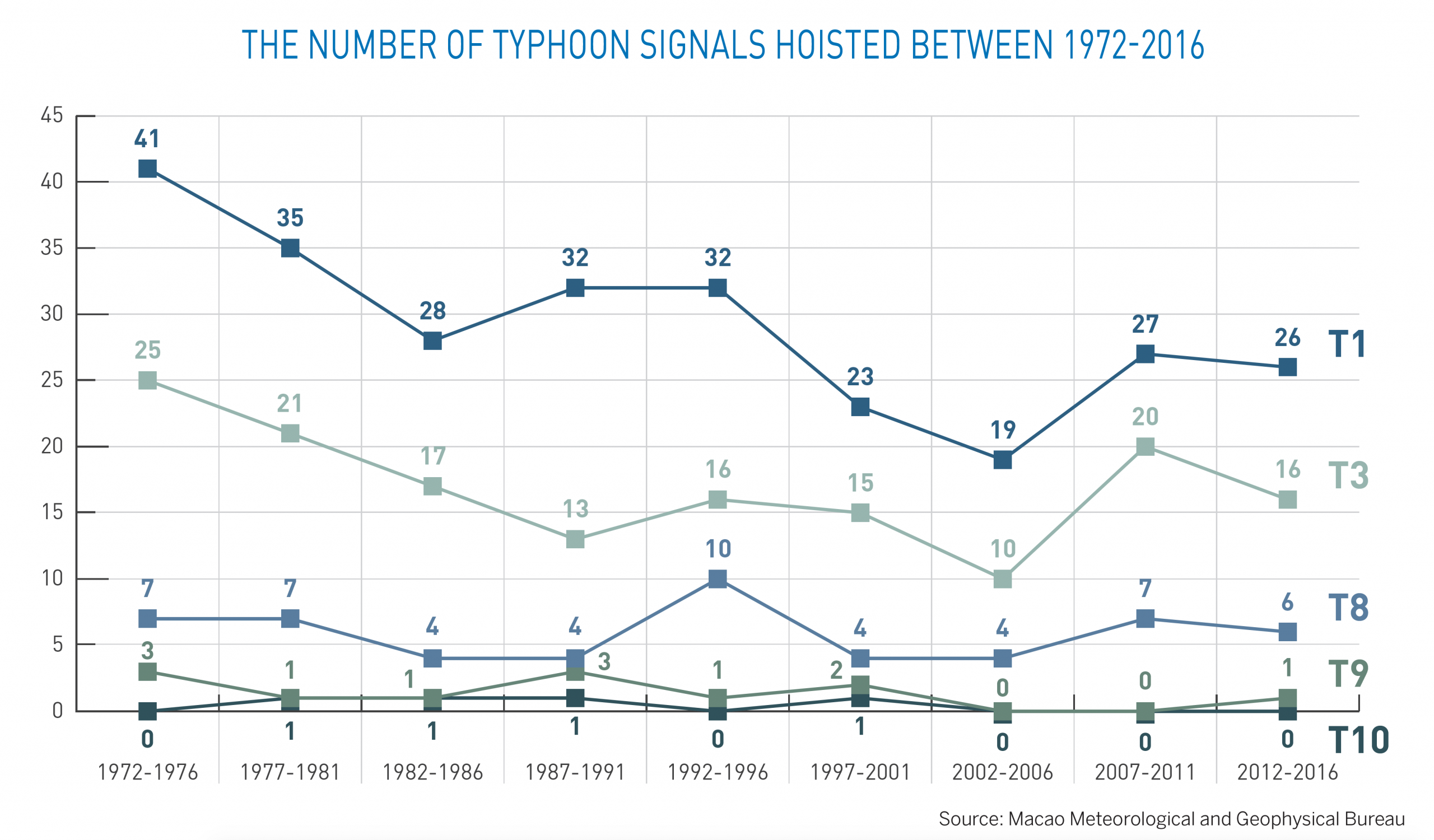
The Unforgettable Typhoon
In the early hours of 22nd September to 23rd September 1874, a strong typhoon ravaged the port of Macao.
In his work Tufões que Assolaram Macau (1957) geographical engineer Agostinho Pereira Natário described it as “the most violent typhoon in memory, causing thousands of deaths and losses worth one million patacas. The settlements of Taipa and Coloane had almost disappeared.”
Contemporary accounts from local sources described it as “the most devastating [typhoon] of all time,” resulting in at least 4,000 deaths, 2,000 vessels lost, several fires, and widespread destruction. A great number of maritime villages never recovered and many public buildings suffered significant damage. The Guia Lighthouse, only a decade old at the time, was so badly damaged it remained out of service until 1910.
